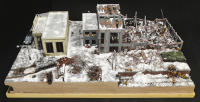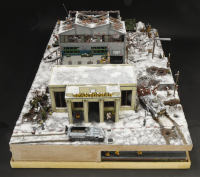
The siege of Stalingrad is often described as a key turning point in the Second World War, and for many it is the single most important one, since it marked the point at which the German advance was not only halted, but reversed. During the siege, the tractor plant, which by this time was producing military vehicles, was a major focus for both sides, and became famous worldwide as the scene of much bitter fighting, during which it was largely destroyed. The subsequent encirclement and capture of the German 6th Army marked the start of a long German retreat which would largely continue until the final battle of the war in Europe - the fight for Berlin itself.
Armour and big guns will have a significant part to play in any battle of World War II, but for an urban conflict such as Stalingrad, the infantry will always have a particularly important role too. So the choice of figure sets for this set was very important, and Italeri decided on:
To our mind these are not great choices. The Germans are an odd assortment of early war uniforms and late war weapons, and not one of them show any sign of fighting in a cold and harsh environment. While the battle for Stalingrad took place over several months, not all of which were cold, the popular image of the battle is one of a winter landscape and soldiers trying desperately to keep warm and well as fight. This old Esci set does none of that, and the later Italeri German Infantry (Winter Uniform) would have been a far better choice in our view. The old Esci Russian Soldiers set is not a great deal better, for although the figures are properly uniformed for the battle, they too show no signs of the winter weather that most customers would expect. Again Italeri had a better alternative available, their Russian Infantry (Winter Uniform), so we must only imagine that the choices were made on grounds other than what was the most suitable for the subject. The PaK 40 and crew is a good choice however, especially as the crew are all dressed for the cold, in contrast to their infantry comrades here. In addition, the set includes the following kits:
- 2 of Italeri T-34/76 m42 (7008)
- 1 of Italeri Panzer Kpfw. IV Ausf. F (7514)
- 1 sprue from the Italeri Urban Accessories (6146)
The tank kits are reasonable choices for this battle, and of course would be crucial in the fight outside of the city itself. The urban accessories set is a nice additional touch, offering some useful accessories to make the scene feel more like one in an ordinary city street.
Naturally the factory itself is by far the largest element in this set. An impressive model when all the parts pictured above are placed together, it is a reasonably faithful depiction of the actual plant, although obviously only a fraction of the size of the complete original. Still it gives a dramatic backdrop to the battle going on in and around it, and the partial ruined aspect of it looks good, although of course the individual modeller can choose to add or change this aspect as they wish.


The usual multiple photographs of a made-up diorama decorate the box. Here the number of liberties taken with what you actually get in the box are large and numerous, starting with the Russian and German soldiers clearly illustrated, yet not what you find inside. The landscape created for this model is particularly complex and detailed, and even includes views of Russian soldiers operating in the sewers. Perhaps most importantly, the modeller has made great use of piles of rubble, battlefield detritus and other clutter as would certainly have been seen during the fight, yet none of which can be created with this product. Giving everything a convincing covering of snow merely underlines our issues with the actual figures included in this set. It's a great diorama, but as the range expanded, Italeri seem to have drifted further and further from what was actually provided in the box, and this is a particularly obvious example.
The factory buildings in this set are terrific, but other than that this is not as good a set as it could have been. The photographed diorama merely illustrates what is wrong here, from the soldiers in neat summer uniforms to the almost complete lack of the rubble and other litter that was such an important part of this crucial battle. The latter may have been beyond Italeri to provide, and indeed is probably best made as required by the customer, but the poor choice of figures is inexcusable, and gives a feel that this product was developed to shift large quantities of very old figures rather than provide a high quality battleset.